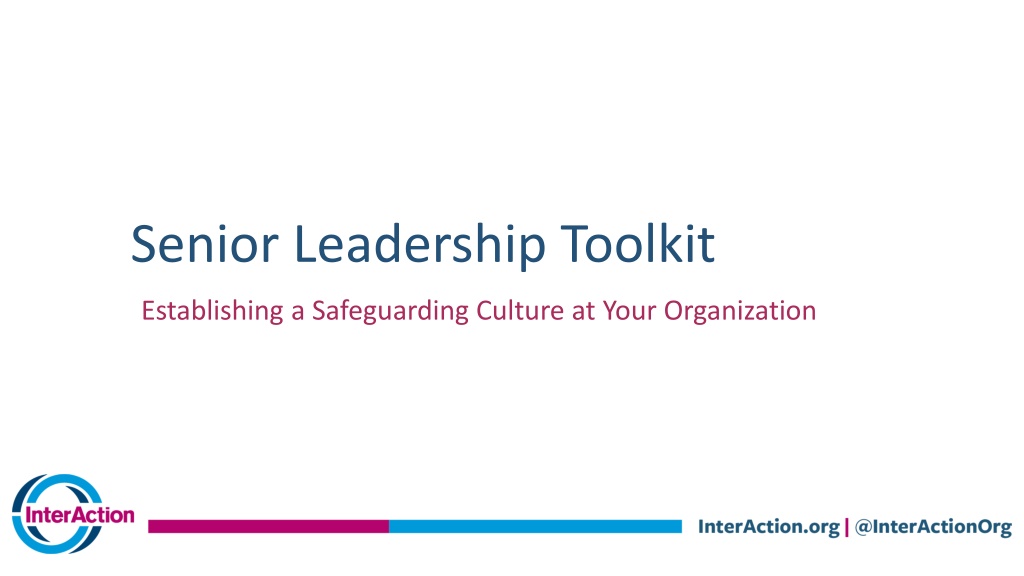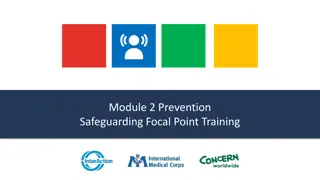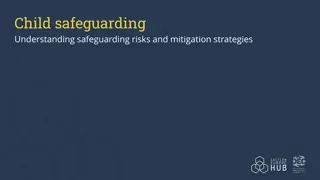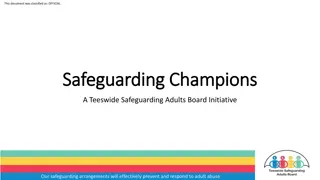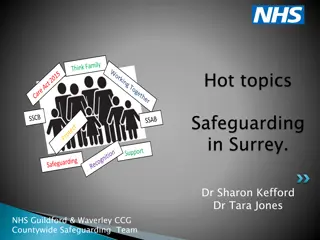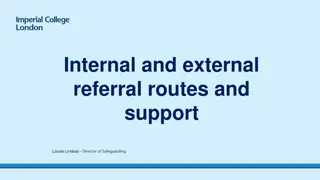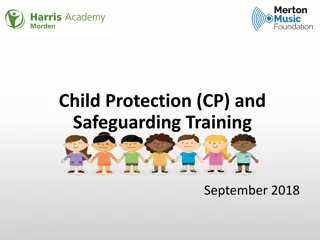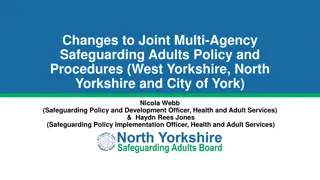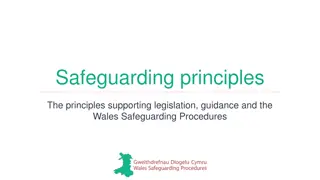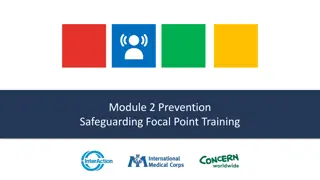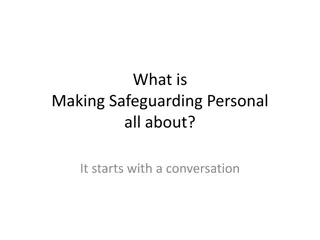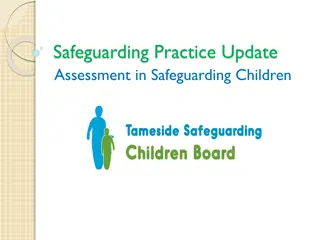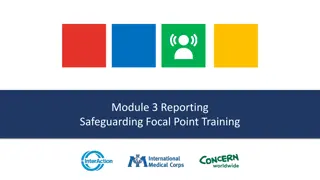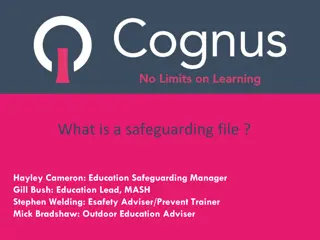Enhancing Safeguarding Culture in Organizations
Exploring the journey of establishing a safeguarding culture within organizations, this toolkit delves into the importance of shared learning, commitment from leadership, and the necessary steps towards compliance and survivor-centered approaches. Reflecting on the significance of organizational culture in addressing safeguarding incidents and promoting accountability, the content emphasizes the need for systemic change and proactive prevention measures.
Download Presentation

Please find below an Image/Link to download the presentation.
The content on the website is provided AS IS for your information and personal use only. It may not be sold, licensed, or shared on other websites without obtaining consent from the author.If you encounter any issues during the download, it is possible that the publisher has removed the file from their server.
You are allowed to download the files provided on this website for personal or commercial use, subject to the condition that they are used lawfully. All files are the property of their respective owners.
The content on the website is provided AS IS for your information and personal use only. It may not be sold, licensed, or shared on other websites without obtaining consent from the author.
E N D
Presentation Transcript
Senior Leadership Toolkit Establishing a Safeguarding Culture at Your Organization
CEO Pledge Commitment Commit to sharing the learning which emerges, including uncomfortable insights, within a confidential learning space, so we can all benefit from each other s experiences and identify how to tackle this issue together InterAction s CEO Pledge
Where are we as a sector? As opposed to 10 years ago, pilots have been conducted, lessons have been collected, risks are understood, and implementation is now what is required. However, the sector is hesitating and will require to be pushed IASC 2021 PSEAH Global Review Right at the epicenter of this tug for compliance and the need for systemic change. Carolina Echegaray, IRC
Approach to Safeguarding Culture Compliance
Approach to Safeguarding Compliance Culture
What is first thing that comes to your mind when you hear there has been a safeguarding incident?
Approach to Safeguarding Organizational risk and reputation Survivor-centered
Why does culture matter? Sexual misconduct is rooted in imbalances of power. We need to reflect on how we use power and privilege and ensure that we create workplaces of respect and accountability, where misconduct is not tolerated, and where senior management communicates, embodies, and enforces ethical standards . UNHCR An ounce of prevention is worth a pound of cure. Benjamin Franklin
Brainstorm What does a culture of safeguarding look like?
Getting Real About Your Safeguarding Culture
What was your initial reaction to the video?
IASC Global Review We are not ahead of the [PSEAH] problem. We are still just reacting. There is an obvious mismatch between Leaders who believe that we are addressing the issue and survivors and safeguarding staff who are clear that we are not [sectorally] doing ok. -Senior Agency Leader at Global Level, IASC Global Review
PSEAH 09 June 2021 Meeting Working group poll #1, responses displayed below along with CEO survey responses to the same question My organization invests the staff and resources necessary to fully operationalize our commitments to InterAction's CEO Pledge. 45% 42% 40% 34% 35% 31% 30% 29% 30% 25% 20% 15% 12% 12% 10% 4% 4% 5% 2% 0% Strongly Disagree Somewhat Disagree Neutral Somewhat Agree Strongly Agree CEO (95) Staff (25)
PSEAH 09 June 2021 Meeting Working group poll #2, responses displayed below along with CEO survey responses to the same question My organization has collective ownership, driven from the top down, to prevent and respond to SEAH. 60% 48% 50% 40% 36% 32% 29% 30% 18% 20% 16% 12% 10% 4% 2% 1% 0% Strongly Disagree Somewhat Disagree Neutral Somewhat Agree Strongly Agree CEO (95) Staff (25)
PSEAH 09 June 2021 Meeting Working group poll #3, responses displayed below along with CEO survey responses to the same question My organization's leadership does everything it can to let staff at all levels know that safeguarding is an organizational priority. For example, bringing it up at meetings, sending e-mails to staff about the importance of PSEAH, and meeting regularly with 80% 73% 72% 70% 60% 50% 40% 27% 30% 20% 7% 10% 0% CEO (95) Staff (25) DISAGREE AGREE
Accountability The Safeguarding Crisis was not about policy and procedure failings, but failings in culture. How did we allow people to behave like this and think they could be without consequences? Sally Proudlove, Safeguarding Specialist, UNICEF Except for a few interviewees at the most senior leadership levels, trust in accountability remains as low as it was in 2010 At all levels of the system, interviewees have concurred that we are not yet seeing evidence of the consequences of SEAH. IASC PSEA Global Review What are some ways we can ensure accountability within our organization for safeguarding incidents?
Transparency In addressing the Mercy Corps Board of Directors on Monday, I challenged them all highly respected leaders and innovators in their fields to continue to lead bravely and to take the lessons learned from the repeated failures of the past back to their own organizations. I urged them to always remember what their board predecessors referred to as a PR disaster grew greater and more fearsome in the dark and could only be addressed through radical transparency and courage. Tania Culver Humphrey How can our organization be more transparent about safeguarding?
Safety/Trust If people can feel safeenough to talk about what s happened to them and we can bring this out, it s hard and it s awful and it s terrible, but that s how things will eventually get better. It s going to save people s lives. Tania Culver Humphrey
Responsibility/Ownership Making your commitment visible Consistency Long-term commitment
Looking Back After talking through all of this, where has our organization done well in the last three years on safeguarding? What are we particularly proud of?
Looking Forward Where can we improve? How will we make those improvements? What will it take?
